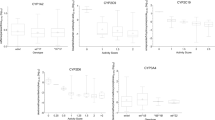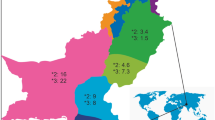Abstract
The aims of this study were to evaluate the diclofenac metabolism in Hispanics from Cuba and Spain and its relation to ethnicity, CYP2C9 genotypes and environmental factors. Diclofenac hydroxylation capacity (concentration ratios of diclofenac/metabolites in 8-h urine) was studied in 160 Cuban (classified as 76 Cuban-Whites—CWs and 84 Cuban-Mestizos—CMs) and 148 Spaniard (SPs) healthy volunteers. Diclofenac and its main metabolites, 4′-hydroxy (OH), 3′-OH and 5-OH diclofenac, and CYP2C9*2 to *6 and *8 alleles were also determined in 132 and 128 CWs and CMs, respectively. Gender, tobacco, caffeine and ethanol consumption were also evaluated. The mean diclofenac/4′-OH diclofenac ratio was higher in CMs (0.72±0.25) than in CWs (0.64±0.20; P<0.05) and SPs (0.57±0.26; P<0.001). The mean diclofenac/4′-OH diclofenac ratio was higher (P<0.05) in subjects with CYP2C9*1/*3 (0.77±0.19; n=22) and CYP2C9*1/*8 (0.93±0.33; n=4) genotypes than with CYP2C9*1/*1 (0.65±0.24; n=90). Environmental factors did not seem to influence the diclofenac metabolism in these populations. The present findings show for the first time interethnic differences between Hispanic groups in urinary diclofenac/4′-OH diclofenac ratios, and the relevance of CYP2C9*3 and CYP2C9*8 alleles.
This is a preview of subscription content, access via your institution
Access options
Subscribe to this journal
Receive 6 print issues and online access
$259.00 per year
only $43.17 per issue
Buy this article
- Purchase on Springer Link
- Instant access to full article PDF
Prices may be subject to local taxes which are calculated during checkout


Similar content being viewed by others
References
Rendic S, Di Carlo FJ . Human cytochrome P450 enzymes: a status report summarizing their reactions, substrates, inducers, and inhibitors. Drug Metab Rev 1997; 29: 413–580.
Nelson DR, Koymans L, Kamataki T, Stegeman JJ, Feyereisen R, Waxman DJ et al. P450 superfamily: update on new sequences, gene mapping, accession numbers and nomenclature. Pharmacogenetics 1996; 6: 1–42.
Miners JO, Birkett DJ . Cytochrome P4502C9: an enzyme of major importance in human drug metabolism. Br J Clin Pharmacol 1998; 45: 525–538.
Goldstein JA . Clinical relevance of genetic polymorphisms in the human CYP2C subfamily. Br J Clin Pharmacol 2001; 52: 349–355.
Bodin L, Verstuyft C, Tregouet DA, Robert A, Dubert L, Funck-Brentano C et al. Cytochrome P450 2C9 (CYP2C9) and vitamin K epoxide reductase (VKORC1) genotypes as determinants of acenocoumarol sensitivity. Blood 2005; 106: 135–140.
Schalekamp T, Brassé BP, Roijers JF, van Meegen E, van der Meer FJ, van Wijk EM et al. VKORC1 and CYP2C9 genotypes and phenprocoumon anticoagulation status: interaction between both genotypes affects dose requirement. Clin Pharmacol Ther 2007; 81: 185–193.
Becker ML, Visser LE, Trienekens PH, Hofman A, van Schaik RH, Stricker BH . Cytochrome P450 2C9 *2 and *3 polymorphisms and the dose and effect of sulfonylurea in type II diabetes mellitus. Clin Pharmacol Ther 2008; 83: 288–292.
Wadelius M, Chen LY, Lindh JD, Eriksson N, Ghori MJ, Bumpstead S et al. The largest prospective warfarin-treated cohort supports genetic forecasting. Blood 2009; 113: 784–792.
Schwarz UI . Clinical relevance of genetic polymorphisms in the human CYP2C9 gene. Eur J Clin Invest 2003; 33: 23–30.
Wiedermann CJ, Stockner I . Warfarin-induced bleeding complications—clinical presentation and therapeutic options. Thromb Res 2008; 122: 13–18.
Dorado P, López-Torres E, Peñas-Lledó EM, Martínez-Antón J, Llerena A . Neurological toxicity after phenytoin infusion in a pediatric patient with epilepsy: influence of CYP2C9, CYP2C19 and ABCB1 genetic polymorphisms. Pharmacogenomics J 2013; 13: 359–361.
Human Cytochrome P450 (CYP) Allele Nomenclature Committee. http://www.cypalleles.ki.se accessed 7 May 2013.
Crespi CL, Miller VP . The R144C change in the CYP2C9*2 allele alters interaction of the cytochrome P450 with NADPH:cytochrome P450 oxidoreductase. Pharmacogenetics 1997; 7: 203–210.
Rettie AE, Wienkers LC, Gonzalez FJ, Trager WF, Korzekwa KR . Impaired (S)-warfarin metabolism catalysed by the R144C allelic variant of CYP2C9. Pharmacogenetics 1994; 4: 39–42.
Wei L, Locuson CW, Tracy TS . Polymorphic variants of CYP2C9: mechanisms involved in reduced catalytic activity. Mol Pharmacol 2007; 72: 1280–1288.
Gotoh O . Substrate recognition sites in cytochrome P450 family 2 (CYP2) proteins inferred from comparative analyses of amino acid and coding nucleotide sequences. J Biol Chem 1992; 267: 83–90.
Imai J, Ieiri I, Mamiya K, Miyahara S, Furuumi H, Nanba E et al. Polymorphism of the cytochrome P450 (CYP) 2C9 gene in Japanese epileptic patients: genetic analysis of the CYP2C9 locus. Pharmacogenetics 2000; 10: 85–89.
Yasar U, Forslund-Bergengren C, Tybring G, Dorado P, Llerena A, Sjöqvist F et al. Pharmacokinetics of losartan and its metabolite E-3174 in relation to the CYP2C9 genotype. Clin Pharmacol Ther 2002; 71: 89–98.
Kirchheiner J, Bauer S, Meineke I, Rohde W, Prang V, Meisel C et al. Impact of CYP2C9 and CYP2C19 polymorphisms on tolbutamide kinetics and the insulin and glucose response in healthy volunteers. Pharmacogenetics 2002; 12: 101–109.
Caraco Y, Muszkat M, Wood AJ . Phenytoin metabolic ratio: a putative marker of CYP2C9 activity in vivo. Pharmacogenetics 2001; 11: 587–596.
Dickmann LJ, Rettie AE, Kneller MB, Kim RB, Wood AJ, Stein CM et al. Identification and functional characterization of a new CYP2C9 variant (CYP2C9*5) expressed among African Americans. Mol Pharmacol 2001; 60: 382–387.
Allabi AC, Gala JL, Horsmans Y, Babaoglu MO, Bozkurt A, Heusterspreute M et al. Functional impact of CYP2C95, CYP2C96, CYP2C98, and CYP2C911 in vivo among black Africans. Clin Pharmacol Ther 2004; 76: 113–118.
Kidd RS, Curry TB, Gallagher S, Edeki T, Blaisdell J, Goldstein JA . Identification of a null allele of CYP2C9 in an African-American exhibiting toxicity to phenytoin. Pharmacogenetics 2001; 11: 803–808.
Blaisdell J, Jorge-Nebert LF, Coulter S, Ferguson SS, Lee SJ, Chanas B et al. Discovery of new potentially defective alleles of human CYP2C9. Pharmacogenetics 2004; 14: 527–537.
Liu Y, Jeong H, Takahashi H, Drozda K, Patel SR, Shapiro NL et al. Decreased warfarin clearance associated with the CYP2C9 R150H (*8) polymorphism. Clin Pharmacol Ther 2012; 91: 660–665.
Xie HG, Prasad HC, Kim RB, Stein CM . CYP2C9 allelic variants: ethnic distribution and functional significance. Adv Drug Deliv Rev 2002; 54: 1257–1270.
Dorado P, Berecz R, Norberto MJ, Yasar U, Dahl ML, LLerena A . CYP2C9 genotypes and diclofenac metabolism in Spanish healthy volunteers. Eur J Clin Pharmacol 2003; 59: 221–225.
Scott SA, Jaremko M, Lubitz SA, Kornreich R, Halperin JL, Desnick RJ . implications for pharmacogenetic dosing. Pharmacogenomics 2009; 10: 1243–1255.
Zhou SF, Zhou ZW, Huang M . Polymorphisms of human cytochrome P450 2C9 and the functional relevance. Toxicology 2010; 278: 165–188.
Dorado P, Beltrán LJ, Machín E, Peñas-Lledó EM, Terán E, Llerena A et al. Losartan hydroxylation phenotype in an Ecuadorian population: influence of CYP2C9 genetic polymorphism, habits and gender. Pharmacogenomics 2012; 13: 1711–1717.
Davies NM, Anderson KE . Clinical pharmacokinetics of diclofenac. Therapeutic insights and pitfalls. Clin Pharmacokinet 1997; 33: 184–213.
Bort R, Mace K, Boobis A, Gomez-Lechon MJ, Pfeifer A, Castell J . Hepatic metabolism of diclofenac: role of human CYP in the minor oxidative pathways. Biochem Pharmacol 1999; 58: 787–796.
Dorado P, Cavaco I, Cáceres MC, Piedade R, Ribeiro V, Llerena A . Relationship between CYP2C8 genotypes and diclofenac 5-hydroxylation in healthy Spanish volunteers. Eur J Clin Pharmacol 2008; 64: 967–970.
Shimamoto J, Ieiri I, Urae A, Kimura M, Irie S, Kubota T et al. Lack of differences in diclofenac (a substrate for CYP2C9) pharmacokinetics in healthy volunteers with respect to the single CYP2C9*3 allele. Eur J Clin Pharmacol 2000; 56: 65–68.
Yasar U, Eliasson E, Forslund-Bergengren C, Tybring G, Gadd M, Sjoqvist F et al. The role of CYP2C9 genotype in the metabolism of diclofenac in vivo and in vitro. Eur J Clin Pharmacol 2001; 57: 729–735.
Morin S, Loriot MA, Poirier JM, Tenneze L, Beaune PH, Funck-Brentano C et al. Is diclofenac a valuable CYP2C9 probe in humans? Eur J Clin Pharmacol 2001; 56: 793–797.
Takanashi K, Tainaka H, Kobayashi K, Yasumori T, Hosakawa M, Chiba K . CYP2C9 Ile359 and Leu359 variants: enzyme kinetic study with seven substrates. Pharmacogenetics 2000; 10: 95–104.
LLerena A, Cobaleda J, Martínez C, Benítez J . Interethnic differences in drug metabolism: influence of genetic and environmental factors on debrisoquine hydroxylation phenotype. Eur J Drug Metab Pharmacokinet 1996; 21: 129–138.
Tatsumi A, Ikegami Y, Morii R, Sugiyama M, Kadobayashi M, Iwakawa S . Effect of ethanol on S-warfarin and diclofenac metabolism by recombinant human CYP2C9.1. Biol Pharm Bull 2009; 32: 517–519.
Mwinyi J, Cavaco I, Yurdakok B, Mkrtchian S, Ingelman-Sundberg M . The ligands of estrogen receptor α regulate cytochrome P4502C9 (CYP2C9) expression. J Pharmacol Exp Ther 2011; 338: 302–309.
Dorado P, Berecz R, Caceres MC, LLerena A . Analysis of diclofenac and its metabolites by high-performance liquid chromatography: relevance of CYP2C9 genotypes in diclofenac urinary metabolic ratios. J Chromatogr B Analyt Technol Biomed Life Sci 2003; 789: 437–442.
Yasar U, Aklillu E, Canaparo R, Sandberg M, Sayi J, Roh HK et al. Analysis of CYP2C9*5 in Caucasian, Oriental and black-African populations. Eur J Clin Pharmacol 2002; 58: 555–558.
LLerena A, Dorado P, O’Kirwan F, Jepson R, Licinio J, Wong ML . Lower frequency of CYP2C9*2 in Mexican-Americans compared to Spaniards. Pharmacogenomics J 2004; 4: 403–406.
Dorado P, Sosa-Macias MG, Peñas-Lledó EM, Alanis-Bañuelos RE, Wong ML, Licinio J et al. CYP2C9 allele frequency differences between populations of Mexican-Mestizo, Mexican-Tepehuano, and Spaniards. Pharmacogenomics J 2011; 11: 108–112.
Xiong Y, Wang M, Fang K, Xing Q, Feng G, Shen L et al. A systematic genetic polymorphism analysis of the CYP2C9 gene in four different geographical Han populations in mainland China. Genomics 2011; 97: 277–281.
Allabi AC, Gala JL, Horsmans Y . CYP2C9, CYP2C19, ABCB1 (MDR1) genetic polymorphisms and phenytoin metabolism in a Black Beninese population. Pharmacogenet Genomics 2005; 15: 779–786.
Helldén A, Bergman U, Engström Hellgren K, Masquelier M, Nilsson Remahl I, Odar-Cederlöf I et al. Fluconazole-induced intoxication with phenytoin in a patient with ultra-high activity of CYP2C9. Eur J Clin Pharmacol 2010; 66: 791–795.
Subramanian M, Agrawal V, Sandee D, Tam HK, Miller WL, Tracy TS . Effect of P450 oxidoreductase variants on the metabolism of model substrates mediated by CYP2C9.1, CYP2C9.2, and CYP2C9.3. Pharmacogenet Genomics 2012; 22: 590–597.
Perini JA, Vargens DD, Santana IS, Moriguchi EH, Ribeiro-Dos-Santos AK, Tsutsumi M et al. Pharmacogenetic polymorphisms in Brazilian-born, first-generation Japanese descendants. Braz J Med Biol Res 2009; 42: 1179–1184.
Acknowledgements
The study has been partly supported by the Institute of Health Carlos III-FIS and the European Union (FEDER) Grants PI10/02010 and PI10/02758, and by the Gobierno de Extremadura and FEDER Grants PRIS11051 and BS10023. This work also received a proportion of funding from AEXCID Cooperación Extremeña of the Junta de Extremadura (11IA002) to SIFF Sociedad Iberoamericana de Farmacogenetica, and it was coordinated in the RIBEF network (Red Iberoamericana de Farmacogenética y Farmacogenómica; www.ribef.com).
Author information
Authors and Affiliations
Corresponding author
Ethics declarations
Competing interests
The authors declare no conflict of interest.
PowerPoint slides
Rights and permissions
About this article
Cite this article
Llerena, A., Alvarez, M., Dorado, P. et al. Interethnic differences in the relevance of CYP2C9 genotype and environmental factors for diclofenac metabolism in Hispanics from Cuba and Spain. Pharmacogenomics J 14, 229–234 (2014). https://doi.org/10.1038/tpj.2013.28
Received:
Revised:
Accepted:
Published:
Issue Date:
DOI: https://doi.org/10.1038/tpj.2013.28
Keywords
This article is cited by
-
Relationships between CYP1A2, CYP2C9, CYP2C19, CYP2D6 and CYP3A4 metabolic phenotypes and genotypes in a Nicaraguan Mestizo population
The Pharmacogenomics Journal (2021)
-
Effects of CYP2C9*1/*3 genotype on the pharmacokinetics of flurbiprofen in Korean subjects
Archives of Pharmacal Research (2015)



